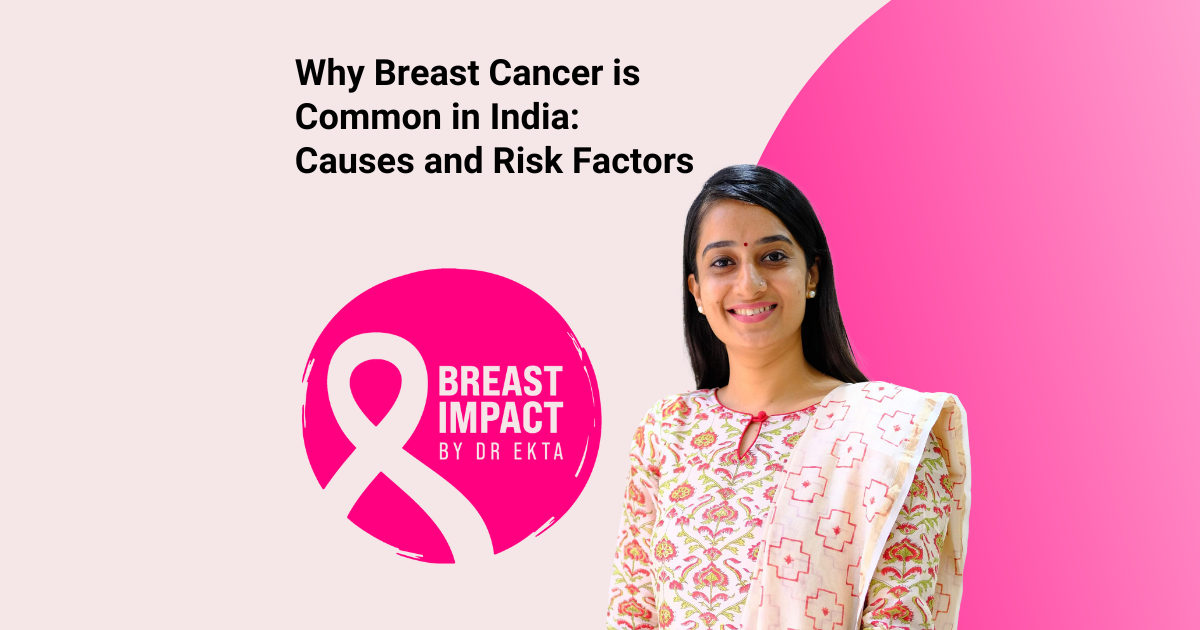As an oncologist, I have witnessed firsthand the alarming rise in breast cancer cases in India. Understanding why breast cancer is common in India requires delving into various causes and risk factors. In this blog, I will share insights into the reasons behind the increasing prevalence of breast cancer in India and highlight key contributing factors.
Socioeconomic Factors: Why Breast Cancer is Common in India
One of the primary reasons why breast cancer is common in India is the country’s socioeconomic transition. Rapid urbanization and lifestyle changes have led to increased exposure to risk factors associated with breast cancer. As more women join the workforce and adopt sedentary lifestyles, the prevalence of obesity and physical inactivity—both significant risk factors for breast cancer—has risen. Moreover, dietary patterns have shifted towards higher consumption of processed and high-fat foods, contributing to the rise in obesity rates.
Reproductive Factors: Key Reasons for Breast Cancer in India
Reproductive factors play a crucial role in understanding why breast cancer is common in India. Changes in reproductive behaviors, such as delayed childbearing, fewer childbirths, and reduced breastfeeding duration, have been linked to increased breast cancer risk. Traditionally, Indian women had multiple children and breastfed for extended periods, which provided a protective effect against breast cancer. However, modern family planning trends have altered these practices, thereby increasing susceptibility to breast cancer.
Genetic Predisposition: A Major Cause of Breast Cancer in India
Genetic predisposition is another important factor explaining why breast cancer is common in India. Studies have shown that certain genetic mutations, such as BRCA1 and BRCA2, are prevalent among Indian women. These mutations significantly elevate the risk of developing breast cancer. While genetic screening and counseling are available, they are not yet widespread, leaving many women unaware of their heightened risk.
Lack of Awareness and Screening: Why Breast Cancer is Diagnosed Late in India
A significant reason why breast cancer is common in India is the lack of awareness and inadequate screening programs. Many women in India are unaware of the importance of regular breast self-examinations and mammograms. Early detection is crucial for effective treatment and improved survival rates, but cultural taboos and limited access to healthcare facilities hinder widespread adoption of screening practices. Consequently, many cases are diagnosed at advanced stages, reducing the chances of successful treatment.
Environmental Factors: How Pollution Contributes to Breast Cancer in India
Environmental factors also contribute to why breast cancer is common in India. Exposure to pollutants and endocrine-disrupting chemicals, often found in pesticides and industrial waste, can increase breast cancer risk. India’s rapid industrialization has led to environmental pollution, which may play a role in the rising breast cancer incidence. Furthermore, urban areas with high pollution levels have been correlated with higher breast cancer rates.
Hormonal Factors: Impact on Breast Cancer Prevalence in India
Hormonal factors significantly influence why breast cancer is common in India. The use of hormone replacement therapy (HRT) and oral contraceptives has been linked to an increased risk of breast cancer. As more women in India use these hormonal treatments, their risk of developing breast cancer may rise. Additionally, early menarche and late menopause, which are influenced by hormonal changes, are also risk factors for breast cancer.
Lifestyle Factors: Modern Choices Leading to Breast Cancer in India
Lifestyle choices are a major aspect of why breast cancer is common in India. Increased alcohol consumption and smoking rates among women are alarming trends. Both alcohol and tobacco use are well-documented risk factors for breast cancer. While traditional Indian culture generally discouraged these habits, globalization and changing social norms have led to higher prevalence rates, contributing to the increase in breast cancer cases.
Obesity and Physical Inactivity: Major Risk Factors for Breast Cancer in India
Obesity and physical inactivity are significant contributors to why breast cancer is common in India. As mentioned earlier, the shift towards sedentary lifestyles and unhealthy diets has resulted in higher obesity rates. Obesity is associated with increased estrogen levels, which can promote the development of breast cancer. Additionally, lack of physical activity is linked to higher breast cancer risk, emphasizing the need for public health initiatives promoting active lifestyles.
Healthcare Infrastructure: Challenges in Addressing Breast Cancer in India
The state of healthcare infrastructure in India is another factor explaining why breast cancer is common in India. While there are advanced medical facilities in urban areas, rural regions often lack access to quality healthcare. This disparity means that women in rural areas may not receive timely diagnoses or treatments, leading to poorer outcomes. Enhancing healthcare infrastructure and ensuring equitable access to cancer care are essential for addressing this issue.
Cultural Barriers: Social Factors Affecting Breast Cancer Detection in India
Cultural barriers significantly impact why breast cancer is common in India. Societal stigmas and misconceptions about cancer can prevent women from seeking medical help. Fear of social ostracization and the belief that cancer is a fatal and incurable disease deter many from getting screened or treated. Educational campaigns to break these cultural barriers are crucial for early detection and treatment of breast cancer.
Diet and Nutrition: Role in Breast Cancer Risk in India
Diet and nutrition are pivotal in understanding why breast cancer is common in India. A diet high in fat and low in fruits and vegetables has been linked to increased breast cancer risk. The traditional Indian diet, rich in spices, legumes, and vegetables, has shifted towards more Westernized eating habits. Promoting healthy eating habits and educating the population about the importance of a balanced diet can help mitigate this risk.
Stress and Mental Health: Emerging Concerns for Breast Cancer in India
Stress and mental health are emerging areas of interest in explaining why breast cancer is common in India. Chronic stress and poor mental health can influence hormonal balances and immune function, potentially increasing breast cancer risk. The pressures of modern life, including work stress, financial concerns, and family responsibilities, can contribute to higher stress levels among Indian women. Addressing mental health through supportive services and stress management programs is vital.
Research and Data Collection: Understanding Breast Cancer Trends in India
Lastly, improving research and data collection is essential to fully understand why breast cancer is common in India. Comprehensive data on breast cancer incidence, risk factors, and outcomes are necessary for developing targeted interventions. Investing in research infrastructure and encouraging collaboration between institutions can provide valuable insights into the disease and guide public health strategies.
Conclusion
In conclusion, understanding why breast cancer is common in India involves examining a multitude of factors, including socioeconomic changes, reproductive behaviors, genetic predisposition, environmental exposures, and lifestyle choices. Addressing this public health challenge requires a multifaceted approach, encompassing awareness campaigns, improved screening programs, enhanced healthcare infrastructure, and cultural shifts. By tackling these issues collectively, it is possible to reduce the burden of breast cancer in India and improve outcomes for those affected by this disease.

